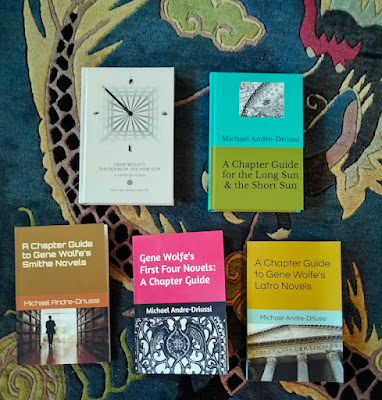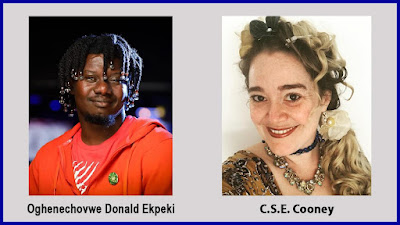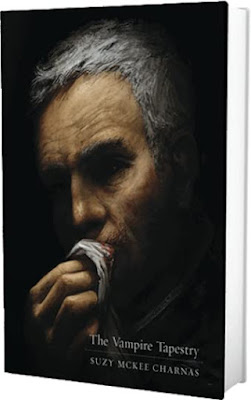.
Look what came in the mail! Michael Andre-Driussi's series of chapter guides to the works of Gene Wolfe.
Michael Andre-Driussi is easily one of the best scholars of Gene's works. And the chapter guides are a particularly interesting critical form because they do not tell you what to think about any particular work. Rather, they guide you through the work, chapter by chapter, drawing your attention to things that should be noticed. Thus they allow you to make up your own mind about what is going on in a particular work.
This is a fruitful way to approach Wolfe's oeuvre because so much of its intent is conveyed by hints and suggestions. He apparently thought that any reasonably attentive reader could pick up on all of them. In this, as in so few other matters, however, he was wrong.
Yesterday, I took a quick tour of The Fifth Head of Cerberus. Today, when my work is done, I hope to begin a much slower amble through Peace. These were, respectively, Gene's second and third novels. The man was an early bloomer!
And did I come up with a new crackpot theory about The Fifth Head of Cerberus . . . ?
Why, yes, I did. Thank you for asking.
Veil's Hypothesis, introduced in the first third of the novel, is that the abos native to the planet Sainte Anne are shape-shifters who may have replaced the human settlers, rather than being exterminated long ago. Most readers accept this hypothesis because the anthropologist who is the ostensible author of the second novella, "A Story," by John V. Marsch, has clearly been replaced by Victor, a boy who has been identified as a possible abo, in the final novella, V. R. T.
There are problems with this. The hearsay sightings of abos collected by Marsch are contradictory and unconvincing. Nor is a physical mechanism for the shape-changing ever presented, though Wolfe was clearly able to come up with one, had he needed it. And in V. R. T., it is clear that while Marsch has to some degree become Victor, he retains memories of his life as an anthropologist.
Andre-Driussi's helpful guide draws attention to something I had overlooked on previous readings--a recurrent theme in the second and third novellas of germophobia. The chief evidence that Marsch has become (or is becoming) Victor is the sudden deterioration of his handwriting, which he attributes to being bitten in the hand by a wild cat.
When these facts are put together with strong indications that the supposed shape-shifters can become animals (including cats), it seems much more likely that the abos are viral in nature: intelligent creatures that survive by infecting host animals and humans.
And is this theory original to me . . .?
No, it is not. A quick Web search reveals that Marc Aramini has come up with a far superior and more detailed explanation of the life cycles of the abos and marsh babies--two native species, rather than one, in a paper titled Proving Veil's Hypothesis: Variance Reduction Techniques, Larval Life Cycles on an East Wind, and Shadow Children Riding Mars(c)hmen in The Fifth Head of Cerberus.
I admire Aramini's paper and find it completely convincing. You can find it here.
But it was fun figuring out some small part of it out for myself.
*








